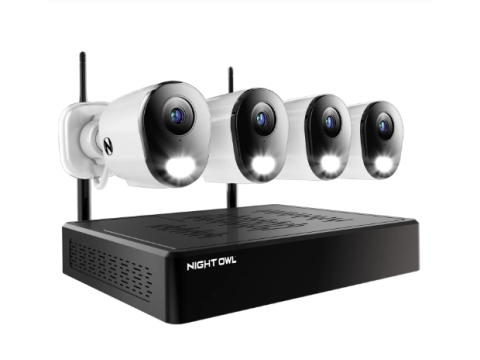Wireless Surveillance Equipment
Wireless surveillance systems use various communication technologies to transmit video and audio signals without the need for cabling. These systems are ideal for locations where wired connections are impractical or too costly.
The main types of technologies include:
- Wi-Fi
- GSM
- WiMAX and Bluetooth
- FM Modulation
Wi-Fi Surveillance Systems
The most popular and versatile type, Wi-Fi-based systems operate on the IEEE 802.11 standard, enabling the creation and expansion of complex surveillance networks.
Required Equipment:
- Wi-Fi Router: A central device for data transmission.
- IP Cameras: Network cameras with integrated Wi-Fi modules.
- Devices for Monitoring: Mobile phones, tablets, laptops, or PCs for system management and video viewing.
Advantages:
- Rapid deployment without cable installation.
- High-quality digital video recording.
- Signal encryption ensures security.
- Minimal electromagnetic interference, safe for humans and pets.
Disadvantages:
- Limited range—real-world distance rarely exceeds 100 meters.
- Higher cost compared to wired systems.
- Regulatory requirements for powerful transmitters over 100 mW.
Typical Equipment Configuration:
- Wi-Fi router (125 Mbps).
- A set of IP cameras.
- DVR or PC with a capture card.
- VGA monitor.
GSM Surveillance Systems
This technology leverages cellular networks for data transmission and is essential for remote areas with no wired or Wi-Fi connectivity.
System Configurations:
- GSM Modem Integration: The system relies on an Internet connection via a SIM card with a fixed IP address.
- SIM-to-SIM Transmission: Video is sent from one SIM card to another, using 3G or GPRS modems for reception.
Advantages:
- Works in areas without fixed-line or Wi-Fi networks.
- Can integrate alarm systems with input/output modules.
- Access is possible from anywhere with GSM coverage.
Disadvantages:
- Low data transmission speed limits video resolution and frame rates.
- High susceptibility to electromagnetic interference.
- Expensive subscription plans.
Typical Equipment Configuration:
- GSM modem.
- Network cameras.
- DVR or PC for recording.
WiMAX and Bluetooth Surveillance Systems
WiMAX:
Uses a more advanced IEEE 802.16 standard than Wi-Fi. It offers long-distance coverage but requires regulatory licensing, making it less suitable for private use.
Bluetooth:
Limited in range (up to 10 meters) and data transfer speed (24 Mbps), this technology is best suited for small-scale, short-range applications.
Advantages:
- High resistance to interference.
- Advanced frequency hopping for security.
Disadvantages:
- Short range.
- Limited equipment options.
Equipment:
- Bluetooth cameras.
- PC or router for data storage and cloud access.
FM Modulation Systems
Operating in the GHz range, these systems can transmit video up to 1.5 kilometers, primarily in non-urban areas.
Advantages:
- Long-distance transmission without amplifiers.
- Cost-effective hardware.
- Eliminates the need for cabling.
Disadvantages:
- Low interference resistance.
- Limited video quality due to narrow FM frequency range.
- Reduced range in urban environments.
Equipment:
- Analog cameras with at least 500 TVL resolution.
- DVR with D1 recording format.
- FM transmission antennas.
Conclusion
Among all options, GSM surveillance systems are often the most practical for monitoring remote locations, especially where traditional communication lines are unavailable.

